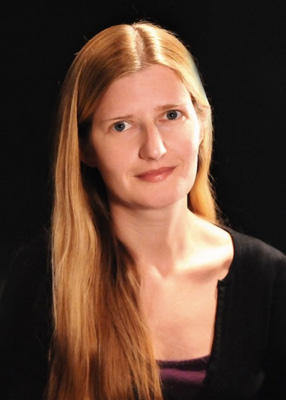

Interview with Elizabeth Hillman

Elizabeth Hillman is an Assistant Professor of Biomedical Engineering and Radiology at Columbia University, NYC, where her research focuses on using light to probe and understand the structure and function of living tissue. She was recently awarded the 2011 OSA Adolph Lomb Medal in recognition of noteworthy contributions to optics before reaching the age of 35.
IDEX Health & Science: How did you get into optics and imaging: Was it a predetermined career choice or driven by scientific curiosity?
Elizabeth Hillman: I always loved Physics and the way it let me predict the things I saw in the world around me. I also had a fascination with medicine, although I did not think I would make a very good clinician. When I was 16, I had an MRI of my back after an injury and was instantly captivated by the images that I saw. I pursued a degree in Physics, and found that applied, more classical physics appealed to me much more than the quantum mechanics and high energy particle physics that I was being encouraged to pursue. Everything came together when I discovered optical imaging, which combines nice, linear, fundamental physics with some tricky quantum and non-linear parts thrown in when you need them. There is a huge breadth of ways in which optics can be used for biomedical research. I get to use physics to generate beautiful images that impact medicine, so it all kind of worked out.
IDEX Health & Science: Like me, you jumped across the Atlantic after your PhD to continue your career in the US. What was the motivation behind such a move?
Elizabeth Hillman: I think most people coming to the end of their PhD find it a rather scary time. I had become somewhat disillusioned with academia during my PhD, and felt a need to see more of how biomedical products are developed and reach their intended end users. A few groups in the US had offered me post-doc positions, which had planted the seed in my mind that I could come to the US for a couple of years to get a new perspective. Then, while at Photonics West, someone came up to me after my talk and offered me a job at a start-up company in Boston. A few weeks later they flew me out to interview, and it just seemed like a great opportunity to learn something completely new, while also having a decent paycheck for the first time.
IDEX Health & Science: What was the attraction in leaving an industrial-based role (with Argose, Inc,) to jump back into academia?
Elizabeth Hillman: I learned a lot while working at the company. I very quickly broadened my knowledge and expertise, and faced a great many challenges, particularly in terms of project management, instrument standardization and FDA approval processes. However, I found myself quite isolated from the rich environment of academic research, where ideas are shared freely and a person has the freedom to pursue new avenues of investigation as they arise. I even missed things like reviewing papers. I also realized that in the US, there were a lot of opportunities for collaborations between academia and industry, as well as wider opportunities for commercialization within universities. I accepted a position as a post-doc at Massachusetts General Hospital / Harvard Medical School, and felt really good about the decision! I often tell students this story and encourage them to follow the same path if they feel the need to explore different career options. Not only did I learn a lot of very valuable lessons and skills in industry, I realized the things that were most important to me, giving me much better focus in my academic work from thereon.
IDEX Health & Science: Your current research interests center on using optics to understand and probe the behavior of living tissue. What is currently the most important research question in your discipline and how can optics be used to solve this?
Elizabeth Hillman: I can’t possibly pick one! That is the real beauty of in-vivo optical imaging; it can provide valuable information about so many things. That said, a large part of my research currently focuses on using optics to study the relationship between blood flow and neuronal activity in the living brain. We know very little about how the brain controls its blood flow, yet it is a vital part of normal brain function. This has been so difficult to study in the past because a lot of conventional neuroscience techniques are performed in-vitro, where neither the central nervous system, nor the cardiovascular system are intact. We needed to develop imaging techniques that can extract information from the living intact brain, with minimal disruption to its normal function. Getting information about multiple parameters in parallel is really critical, since we want to see how everything is working together in real time. Optical imaging and microscopy are perfect tools for these studies; allowing multi-scale imaging from camera-based wide-field hyperspectral imaging to in-vivo 3D two-photon microscopy at micron length scales. The rich contrast provided by ever-expanding tools such as targeted and active fluorescent proteins, calcium sensitive dyes and targeted probes, on top of intrinsic contrast from the different absorption properties of oxy- and deoxy-hemogloin, and intrinsic fluorescence from NADH and FAD provide a palette of information about the living brain that cannot be matched by any other imaging modality. The advent of new optical manipulation techniques such as optogenetics and photo-uncaging add even more exciting opportunities for in-vivo neuroscience research using light.
IDEX Health & Science: As new optical techniques and methods are transferred from research laboratories into clinical settings what do you believe will be their true impact for future human health?
Elizabeth Hillman: Most people could recognize an MRI, ultrasound or x-ray image, but optical techniques come in many different forms. There have been a number of success stories for optical technologies in the clinic: Pulse oximetry and endoscopy have had major impacts on clinical practice. More recently, optical coherence tomography (OCT) of the eye has been widely adopted. However, each of these is a very different technology representing a good solution to a particular problem. In general, optical methods are really good for looking at superficial tissues, so being able to get a fairly direct view of the tissue of interest is important. For this reason, I am currently excited about the potential of optical imaging techniques for intrasurgical imaging. I think improvements in digital imaging hardware, hyperspectral and fluorescence data acquisition techniques, and computing power for online analysis, as well as a trend towards minimally invasive surgeries that already use cameras to relay images make this a great opportunity for optics. Applications could include guidance for surgical resection of tumors, location of lymph nodes, or evaluation of perfusion in organs and tissues that have been damaged, repaired or transplanted. Optical imaging can generally be implemented in a way that is significantly cheaper, more portable and less invasive and obtrusive than other modalities, while providing a rich palette of functional contrast.
Beyond clinical imaging though, we should not ignore the significant impact that optics has had on biomedical research. Confocal and two-photon microscopes are used every day in labs that are working to understand a vast array of diseases and their treatments, from diabetes to cancer, Alzheimer’s and AIDs. Small animal optical molecular imaging is being used to develop ways to target contrast agents and therapeutics to tumors, as well as to track diseases pathogenesis and treatment responses longitudinally and non-invasively. In a sense, improving the tools for such basic research can feasibly have broader and more immediate impacts on human health than optical techniques used directly for clinical diagnostics.
IDEX Health & Science: Academic-industry partnerships can serve as the catalyst to revolutionize scientific breakthroughs. What is your perspective? Does this happen often enough and what can be done to accelerate the development of next-generation imaging technologies for the treatment and understanding of common human diseases?
Elizabeth Hillman: Universities have become much more sophisticated in the way that they handle intellectual property. This is a good thing, in that it ensures that academic researchers properly protect their ideas, and promotes academic research with real-world relevance. However, moving technologies forward into commercialization can be a real struggle. My DyCE small animal imaging technique is licensed and has been commercialized, but I was fortunate to already have contacts to market the idea to, and the company did a great job of quickly implementing the technique on an existing platform. For ideas that require more development, the amount of work required on both sides can be overwhelming. I think successful collaborations need to recognize that very different forces drive the work performed in academic labs versus industry. In academia, progress is judged in terms of papers published and students graduated, compared to industrial timelines and decisions driven by marketing concerns and intellectual property. I think both sides would benefit from an appreciation of how conflicting these perspectives can be. In the end, I believe it comes down to the people involved. Not all academics have the desire (or experience) to pursue commercial translation of their ideas, so I see this as a gap that needs to be bridged if the most impactful and beneficial technologies are to be successfully commercialized.
IDEX Health & Science: Who has had the most influence on your career and work, and why?
Elizabeth Hillman: I would have to say Prof David Delpy FRS, who was my PhD co-advisor and our Department Chair during my graduate studies at University College London (UCL). He is now CEO of the Engineering and Physical Sciences Research Council (EPSRC) in the UK. I remember the first time I met Dave, during my tour of UCL as a prospective undergrad. His enthusiasm was infectious, and once I took his class on ‘Physiological Monitoring’ I was hooked on pursuing a career that combined the rigor of physics, engineering and mathematics with the fascinating and impactful questions posed by medicine. He was kind to me when I needed a little encouragement, and inspirational when tackling a scientific question. I also really appreciated that he, and all of my other professors and colleagues, never let it enter into my mind that I was pursuing a career that was not a typical one for a woman. In fact, I credit the all-girls senior school that I attended before university for letting me grow up blissfully unaware of people’s preconceptions in this regard. So I guess I should mention my teachers there, and my mum for giving me the confidence to follow my interests.
